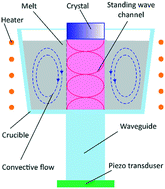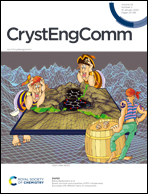Opportunities of striation-free crystal growth with ultrasound effect†
Abstract
The main condition for elimination of growth striations is the formation of standing waves in the melt for damping of convection. The formation of standing waves between the crucible bottom and the solid–liquid interface suppresses convection in the melt and eliminates growth striations in single crystals. Growth striations in InSb and GaAs single crystals were eliminated after the ultrasound was switched on at frequencies of 0.65 MHz and 0.15 MHz in their melts with the Rayleigh numbers 0.18 × 105 and 0.2 × 105, respectively. The ultrasound intensity was determined from a model experiment with similar conditions to crystal growth using a light cut method. The model experiments demonstrated formation of standing waves above the waveguide with a piezo transducer after switching on the ultrasound that attended appearance of a dome on a liquid surface. The dome dimensions on the liquid surface were used for calculation of the ultrasound intensity. The calculated ultrasound intensity was 0.85 W cm−2. It was found that the growth striations disappeared a certain time after switching the ultrasound on, which can be explained by the formation time of standing waves and properties of the melt. The time intervals between switching the ultrasound on and the elimination of striations in grown InSb and GaAs single crystals were measured using the experimental images with the striation elimination, and were 10 s and 22 s, respectively. The controlled formation of ultrasonic standing waves in the melt in crystal growth eliminates growth striations, and this technique can be used for the industrial application.



 Please wait while we load your content...
Please wait while we load your content...